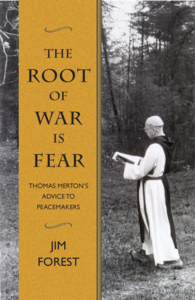The Root of War Is Fear: Thomas Merton’s Advice to Peacemakers
Reviewed by Bill Chapman
February 1, 2017
 By Jim Forest. Orbis Books, 2016. 224 pages. $25/paperback; $20.50/eBook.
By Jim Forest. Orbis Books, 2016. 224 pages. $25/paperback; $20.50/eBook.
Jim Forest was Thomas Merton’s longtime friend and colleague in the peace movement. Forest has previously written well-received biographies of Merton and another colleague, Dorothy Day, with whom he worked at the Catholic Worker. In fact, Forest met Merton through Day.
The Root of War Is Fear focuses primarily on 1960–68, the last eight years of Merton’s life, and on his relationship with Forest. It was a tumultuous time not just for the United States, but for Merton and Catholicism. Merton would struggle to understand what was happening outside the walls of his Kentucky home at the Abbey of Gethsemani, and also to discern his role in that world. This book also lays out the rifts in the Catholic Church that would climax with Pope John XXIII announcing the creation of the Second Vatican Council in 1962, a forum to address relations between the Catholic Church and its modern members.
By 1960, Merton had authored nearly 20 books of poetry and spiritual writing, including the best-selling and highly influential autobiography, The Seven Storey Mountain. He was much loved among Roman Catholics for his writing on the contemplative life. Many young Catholic men flocked to monasteries all over the world seeking the “elected silence” Merton described in his memoir. Today, many Friends are attracted to the early writing of Merton. The contemplative life that Merton celebrates has many similarities to the silent worship that Friends practice. It is worth noting that Merton’s mother was a Friend.
Starting in the late 1950s, Merton began extensive letter writing with individuals of many different faith traditions about the dangers of a world that he saw spiraling toward a nuclear holocaust. Merton would be influenced by two Quakers: A.J. Muste and Douglas Steere. Muste strongly influenced the writing of Merton by challenging him to look at the violence in each of our own lives as well as governments. Steere would offer a regular diet of Quaker writings (Merton loved Pendle Hill pamphlets) and also a willingness to offer a history of the Friends peace testimony to others in Merton’s orbit. This idea of confronting our own individual violence would become a centerpiece to the writings of Merton on war.
The threat of nuclear proliferation and the stain on humanity left by the U.S. use of the atomic bomb on the Japanese at Hiroshima and Nagasaki weighed heavily on his conscience. Forest spends a good deal of time in this text describing how complicated this was for not only Merton but also the Catholic Church. Merton by 1960 had become highly skeptical of the long-held just war position of the Catholic Church. Forest does a wonderful job laying out the back story of Merton’s increased focus on what was happening in the world and Merton’s need to share his concerns. Merton felt there was a clear and present danger to the planet if we did not deal with our addiction to violence. His writings had now become a full frontal assault on war and the symptoms that lead to “this illness.”
All of Merton’s writings were denied publication by Church censors when presented in book form. He was given permission to send carbon copies out to friends. The story of how voluminous and well-traveled these carbon copies became in the peace community is quite humorous. Forest shares his correspondence with Merton throughout this period. These letters offer an up-close and sometimes painful view of the challenges that both Merton and Forest faced. Merton himself struggled with what his role actually should be and how he could (or should) best serve the growing peace movement. We are given a very real but nuanced image of Merton. Too often Merton has been offered to us as an almost cartoon superhero and not as the very human man he was. Both Merton and Forest are seen, warts and all.
The largest portion of the book is spent dealing with the Vietnam War. Forest became one of the leading voices on the Catholic Left in opposition to the war. As the letters show, Forest grows into an important pair of eyes and a trusted ally for Merton. Both Merton and Forest are saddened and outraged by U.S. foreign policy, and this is apparent in the letters between them. During this period, Muste and Steere visited Merton and urged him to speak out more forcefully to end the war. Both Douglas Steere and his wife, Dorothy, were actively a part of the Second Vatican Council. (Yes, Quakers were considered by the Vatican to be an indispensable part of any document that would address peace.) Merton was then given the green light to write as he wished on any topic. The Catholic Church would also move dramatically closer to the Quaker position on war.
This book offers a fine opportunity to better understand two peacemakers, Thomas Merton and Jim Forest, during perhaps the most meaningful decade of the last century in the Catholic Church. This eight-year journey of Merton and Forest leaves one with a better understanding of not just these two Christian men and their work but also the profound change this period had on Catholicism. It is a timely work that deserves attention in our Friends community.



Comments on Friendsjournal.org may be used in the Forum of the print magazine and may be edited for length and clarity.